Inadequately discussed in this post: 5 Books (Responding to Human Trafficking; High Price; Angry White Men; Anger; and The Complete Stories); 5 Movies (Lady Bird; Call Me By Your Name; After the Storm; The Shape of Water; and The White Ribbon); 4 Documentaries (Angry Inuk; Chasing Coral; Burn, Motherfucker, Burn; and LA 92).
Books
1. Responding to Human Trafficking: Dispossession, Colonial Violence, and Resistance among Indigenous and Racialized Women (2017) by Julie Kaye.
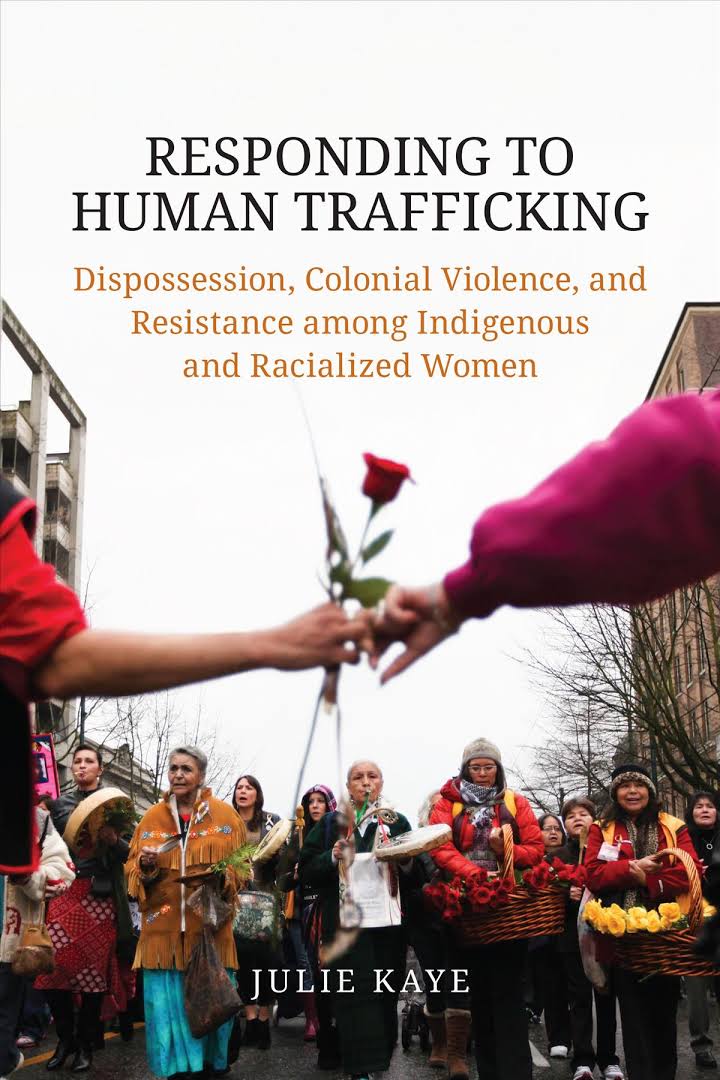
Julie Kaye’s book comes after years of working, networking, and becoming involved in communities of Indigenous women, people who engage in sex work, people who have been trafficked, and the various social services and government bodies that engage with these populations. Kaye draws upon theory but also engaged in fifty-six one-to-one interviews with people in related industries and these interviews provide the backbone of her analysis and conclusions. Essentially, she is interested in the ways in which the discourse about human trafficking (specifically, anti-trafficking), and its concomitant policies and practices, “reinforce the settler-colonial nation-building project of Canada.” In this regard, the divide between “international” and “domestic” trafficking is instructive. What does it mean for Canada to refer to citizens from sovereign nations (nations Canada has colonized), as “domestic victims of trafficking”? Kaye concludes (accurately, imo) that this language is deployed to reinforce Canada’s claim to the land, which then continues to reinforce the dispossession of Indigenous peoples (on this language of dispossession cf. Robert Nichols’ “Theft is Property! The Recursive Logic of Dispossession”). Thus, Canada’s settler-colonial project of nation-building operates on inclusion (with Indigenous women being included and domiciled within Canada as an “at risk” population) and exclusion (with women from elsewhere in the international community being perceived of as a risk). Just as significantly, this anti-trafficking approach reinforces the power and scope of the very agents who have inflicted the most violence on Indigenous peoples – the police, the RCMP, the border guards, and social services (especially those rooted in the Christian faith, notably the Salvation Army which has become a major player in anti-trafficking power moves in Canada). Thus, the very bodies claiming to address colonial legacies are, in fact, being reinforced and empowered to operate in such a way as to maintain and enforce colonial dynamics in the present In all of this, Kaye is especially critical of the anti-trafficking discourse and its way of conflating trafficking with sex work, of then presenting all women involved in those things as victims in need of saviours, of the ways in which the State the police and social services position themselves as those saviours, and of the ways that this boxes out the voices of the vast majority of sex workers and sex worker led organizations who argue that decriminalization of sex work is the approach they want and one that produces far, far better results in terms of individual and communal health and well-being (and the evidence backs up the sex workers on this point). Not to say that the police, government, and social services can’t find former sex workers whom they exploit to reinforce the imposition of a singular victim narrative onto a complex situation (and Kaye explores this), but the anti-trafficking industry plays a lot of sketchy games in how they go about doing this (Kay explores this, too). Of particular concern is the way in which anti-trafficking voices exclude the voices and experiences of those with lived experience of sex work who take a different position (which, again, is the majority position of people with lived experience). Thus, anti-trafficking parties call those who oppose them “sex industry lobbyists” or “powerful sex industry lobbyists,” and misleading the public into thinking that this means pimps, traffickers, or porn corporations — not the day to day people who engage in sex work. Having said that, however, Kaye prioritizes the experiences of Indigenous women (i.e. vast majority of people “domestically trafficked” within Canada, making them massively over-represented given that they make up such a small percentage of the population of people in the territories occupied by Canada). Because of this, Kaye does not acritically accept the positions held by those who take a more “human rights” based approach to sex work (arguing for decriminalization). While I believe Kaye sees decriminalization as a useful, helpful, and meaningful thing, Kaye is more concerned about both finding ways to try and fight against the ongoing Canadian process of colonization and dispossession which she sees as a root problem that will remain regardless of what approach is taken. Kaye argues that decolonization, or something akin to that, must be at the core of these conversations and subsequent policies and practices. In light of this, she is also interested in looking at and affirming ways in which Indigenous women are already engaging in this struggle in ways not necessarily bounded by Canadian social services or government bodies. I very much enjoyed this book. Recommended reading, although it presupposes some awareness about the broader discourse related to anti-trafficking, decriminalization of sex work, and settler colonialism in Canada.
2. High Price: A Neuroscientist’s Journey of Self-Discovery That Challenges Everything You Know About Drugs and Society (2013) by Carl Hart.
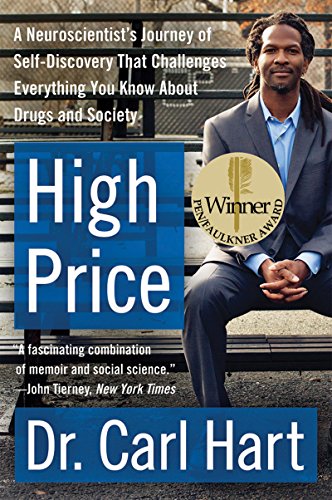
It was an enlightening experience to read Carl Hart’s book shortly after finishing Kate Manne’s book on the logic of misogyny. While Hart presents himself as a person who attained success by overcoming racism and poverty (and the ways in which those two things are deeply interwoven in the USofA – and there is no question that he overcame those things and that they were a lot to overcome), I just kept reading a story about a guy who uses, fucks, exploits (perhaps unwittingly? perhaps with good intentions?) and then discards successive waves of women as he “chases pussy” to the pinnacle of success. Now, granted, observing this takes nothing away from Hart’s excellent observations about race and poverty, and it also takes nothing away from his exceptional research into illicit drugs, what they do and don’t do to people, and all the bullshit myths he exposes about them, but it does temper how I view Carl Hart and, I think, that’s what this book is really about – how Carl Hart wants us to view him (at one point he tells some story about being involved in the underground hiphop scene before it explodes and then says he’s not saying this to let people know he’s not a stereotypical dungeons and dragons science nerd who grew up on a computer in his parents’ basement but, yeah, the gentleman dost protest too much). All this is rather a bummer because Hart’s research into drugs is so important, especially in light of the prevailing discourse about the current crystal meth “epidemic” that is sweeping across Turtle Island, but one has to mine the text and the footnotes to pull out a lot of that. I found this book disappointing. You can probably get more from googling Hart’s name in relation to his research on crack and meth.
3. Angry White Men: American Masculinity at the End of an Era (2013, with an updated post-Trump intro) by Michael Kimmel.
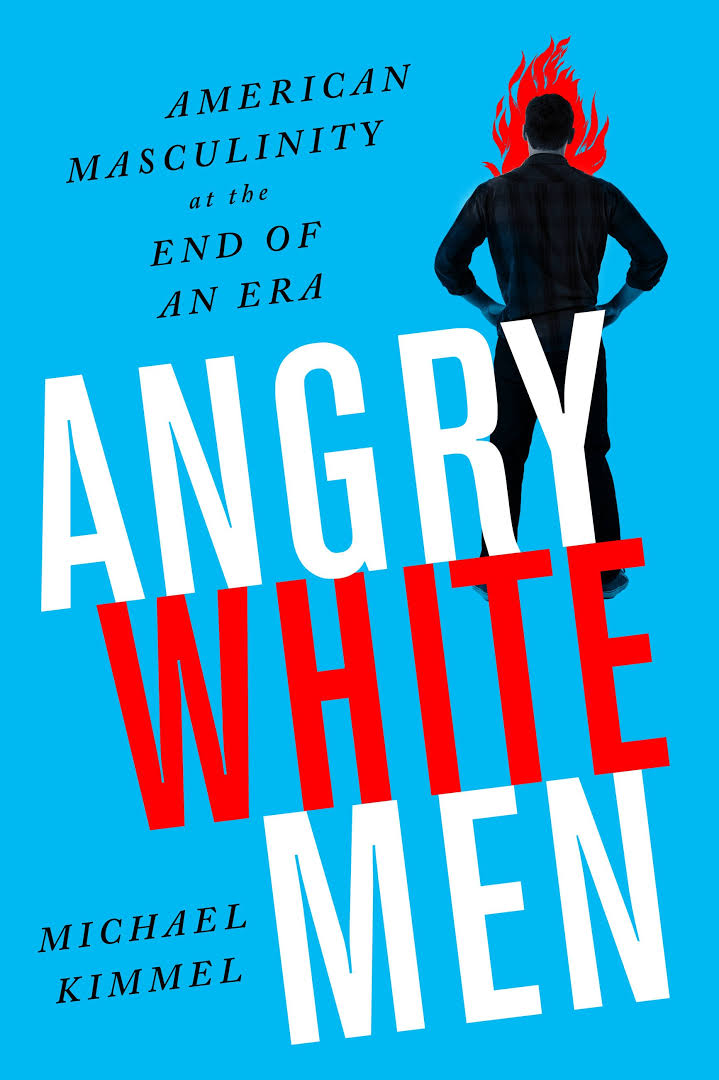
In 2013, Michael Kimmel thought that angry white men were a dying breed. There was no question as to their prevalence and influence but Kimmel thought that, well into the Obama administration, people of colour and women were both on the rise and that men were actually learning to appreciate more diverse communities and communities not dominated by white male privilege and power. So, before they disappeared, Kimmel took a tour through the various bastions of white male anger – from tea partiers to gun show presenters, from three percenters to men’s rights activists, from white supremacists to disillusioned fathers and factory labourers. And then, of course, the Black Lives Matter movement happened and then 2017 happened and Trump became the President of the USofA and, well, white male rage is alive and well and has revealed itself to be far from limited to a certain class or even to the South. It not only survives and thrives. Still, despite Kimmel’s inability to foresee the future (and it’s interesting to think about why that may have been the case), this is still an important study – perhaps all the more important because Kimmel was wrong about where we are going – and it pairs well with Carol Anderson’s book about the history of the self-and-other-destructive rage of white people that has always followed the (real or perceived) successes of people of colour in the USofA, Nell Irvin Painter’s history of white people, and Mark Bray’s examination of fascism and anti-fascism. Anderson, Painter, and Bray provide excellent overviews. Kimmel gets in the trenches and tries to understand the various factions and motivations and points of unification of all these contemporary angry white men. He personalizes the issue – looking at what it means for this man, here, now, the one he met at the gun show who agreed to have coffee with him the next day – but he does this in a way that (imo) avoids the pitfalls that journalists came sometimes stumble into of normalizing Nazism or fascism or whatever (as happened in a recent NYT piece… recognizing the banality of evil while avoiding this kind of normalization may be tricky and efforts in this regard are further complicated by the ways in which, for example, media in the USofA consistently treats “mentally ill white shooters” as different than “evil” black or brown “terrorists”). I enjoyed this book. Recommended reading.
4. Anger: Wisdom for Cooling the Flames (2001) by Thich Nhat Hanh.
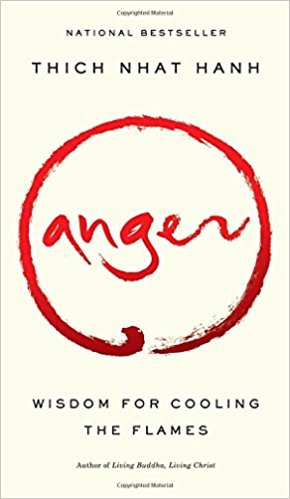
It has been a long time since I sought out any literature that has a spiritual or devotional feel, but given the ways I have been wondering about anger, not only as a broader political force in our context, but also as something that has motivated me in my own struggles, and something that has sometimes popped up in myself in other ways (i.e. in relation to the menial frustrations of daily life), and given some of my current concerns about angry white men (and I am white and a cis-gendered fellow), I thought I would read this text by Thich Nhat Hanh. I’ve always been a little curious about his writings given my earlier love for Thomas Merton and Hanh’s reputation in relation to the civil rights struggle. Hanh writes with a gentle voice, he is direct in the manner that people imagine saints or holy people to be. You know, the whole speaking simple truths in a way that reminds us of how profound they are thing? He does that. And I’m not saying that in a mocking way. He’s pretty good at it and I appreciated a lot of what he said and the practical tools he provides for acknowledging and caring for one’s own anger in such a way as to ensure that you are not harming yourself or others with it. I found a lot of this book to be surprisingly soothing. That said, there were a few times when I thought he gave poor advice. Sometimes, I felt he bordered on victim-blaming, and I think he was too eager to help people exculpate those who had harmed them and that this risked ensuring that patterns of abuse would continue, especially since the structures under-girding the abuse were not questioned. Everything was far too heavily personalized and individualized. For this reason, I felt like Hanh’s text could very easily be appropriated by people who are deeply engaged in profiting from violent structures but who could then use Hanh’s text to help themselves feel like good, kind, moral people. Žižek’s criticisms of “Western Buddhism” are on point here (even though Žižek himself is jerk and, as far as I can tell, stopped saying anything worthwhile some years ago). However, all that said, I believe that Hanh’s text does not necessarily have to be taken in that direction and can still be held alongside of other forms of analysis. There was much that I enjoyed about this and much that I have taken away to practice.
5. The Complete Stories (2015) by Clarice Lispector.
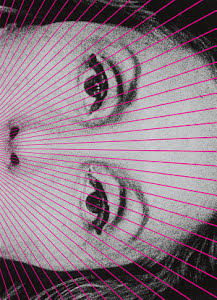
Every now and again I revisit the short story genre but, apart from folk or fairy tales and the very rare one-off experience (with “Cat Person” for example), I struggle a lot to connect with this form of story-telling. I was hoping for a different experience with this six hundred page collection of Lispector’s short stories (presented chronologically) but, alas, apart from stories told in The Via Crucis of the Body, along with a handful of others scattered throughout the rest of the collection, I mostly found this to be rough and slow going. It’s too bad because Lispector is a brilliant writer and so the fault, I reckon, lies more with me than with her. I have come to the conclusion that I tend to prefer longer novels over short stories for the following reasons. I think I am a slow thinker whose thinking accelerates the more I become absorbed into the world of a novel. I like to have a block of time set aside for a text to allow this process of absorption to take place. Short stories, unfortunately, tend to end before I can really get into that zone or have had much time to do much thinking. However, and here I think something like laziness kicks in, instead of stopping to think and really see what I can pull out of a short story, I want to keep on reading because I am looking for that feeling of being lost in the world about which I am reading (I think this goes way back to why I started reading novels to begin with when I was a young child), and so I just skip forward to the next short story, and then the next one, and then the next, and never end up getting where I am looking to go. But, anyway, I do plan to keep reading Lispector because I very much enjoyed The Passion According to G. H. and so if others have suggestions as to which novel of hers I should turn to next, I would appreciate you sharing.
Movies
1. Lady Bird (2017) directed by Greta Gerwig.
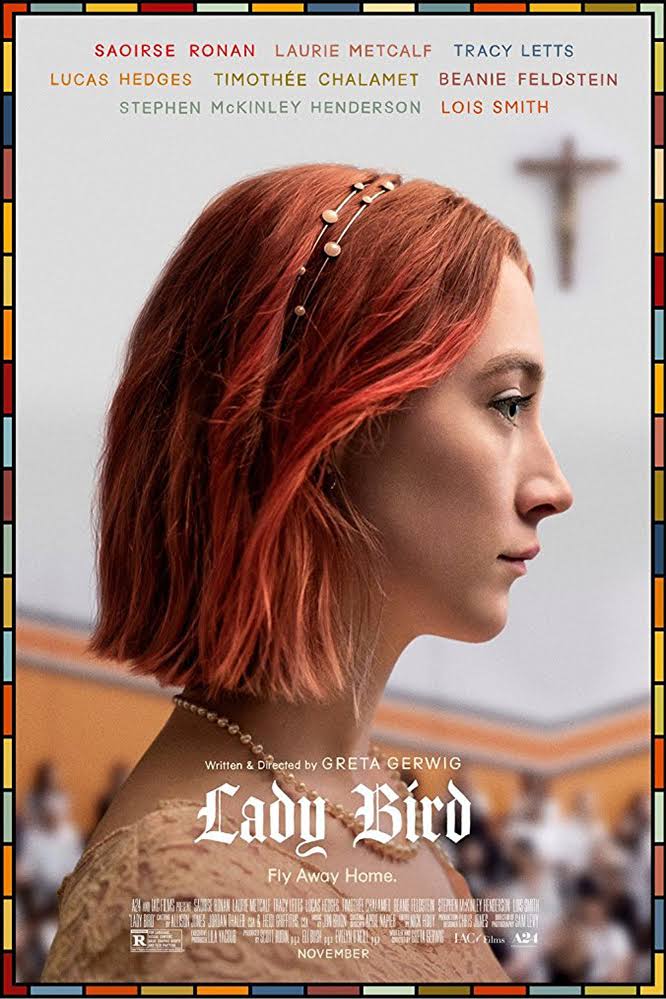
I have mixed feelings about Lady Bird. A coming of age story, I enjoyed its swirl of tenderness, directness, alienation, disappointment, excitement, and struggle – struggle to find one’s self, struggle to find one’s place, struggle to know with whom one should go, not to mention the several struggles related to money and family entwined with all of these. What I didn’t enjoy so much was Lady Bird’s ultimate coming of age and her transformation into Christine (as if that’s who she always was, as if that’s who she was meant to be, as if that’s her true nature) which felt contrived and rushed and risked turning a very beautiful and honest explosion of late teenage life into a morality play valourizing the acceptance of one’ s place within an annihilated and annihilating American life.
2. Call Me By Your Name (2017) directed by Luca Guadagnino.
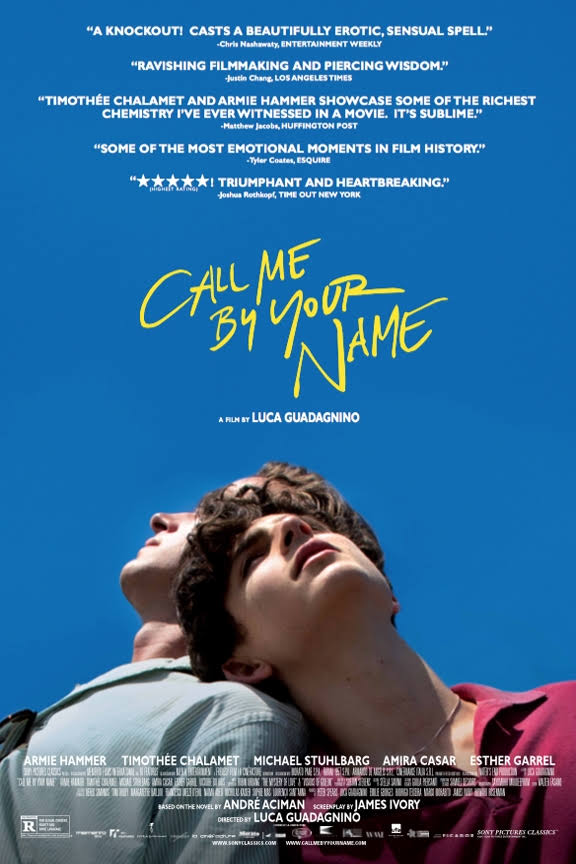
I’ll never look at peaches the same. Although that scene did make me think that maybe I shouldn’t be so quick to write off Guadagnino’s remake of Dario Argento’s Suspiria. Anyway…
A romance tinged with nostalgia for teenage fantasies (I find most romances seem to have plateaued there, which isn’t yet a value judgment, or at least I don’t mean it as such, but it is an observation I am considering), because of course the young fellow is a musical genius and of course the crush can discuss Heidegger, philology, and ancient Greek sculpture all in one breath and of course Italian and French are spoken as much as English and of course this all takes place in a picturesque little town in Europe and of course the people are just as beautiful as the scenery, Call Me By Your Name is as pretty as the crush who first rested their head on your shoulder and knocked the wind out of you simply by brushing your fingertips with theirs. But what sets this apart from other artistically shot stories of first love/summer love, is the fact that the lovers are both male (and the year is 1983). This actually gives this film an immense amount of value – it allows many people left out of the standard heteronormative love story to experience themselves in film and reflect on their own experiences through the film, and it further validates and affirms the beauty and goodness of those experiences in a society where gay-bashing is still a daily thing (and this, by the way, is partly why Boys in the Trees was such a massive letdown — it would have been immensely better if the friends had been lovers but, instead, it turned out to be reheated retro indie horror that has been done better elsewhere and that, to my mind, didn’t really justify its use of gay-bashing). So Call Me By Your Name is a good thing. I’m glad for this movie and glad that I watched it.
3. After the Storm (2016) directed by Hirokazu Kore-eda.
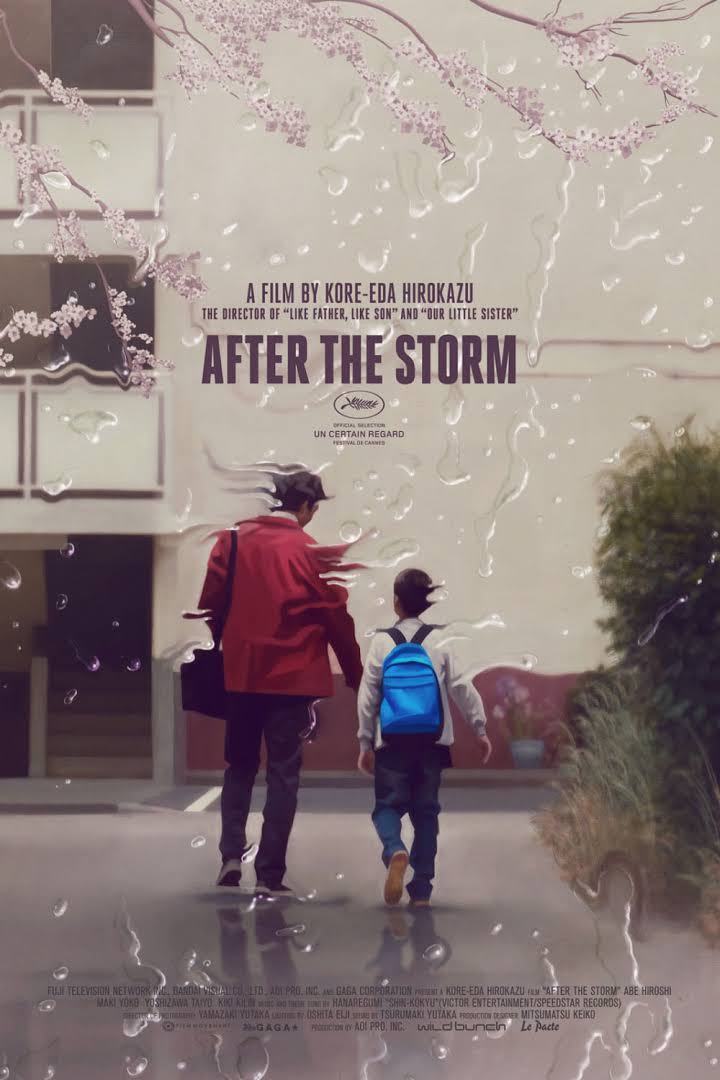
The story of a dad who is too into himself to realize what a crummy dad he is, simply because he is not the kind of person we assume crummy dads to be, this one is a slow sorrow. All the more sorrowful because this is precisely what so many crummy dads are like – too into themselves, overplaying every time they do something kind or generous or exciting, as it that makes them the best dad ever, when really what their kids need is for them to be there for them in the mundane, mess, and whatever else, of their daily lives. Most sorrowful still because we see how the son who longs to be loved by his father, is slowly turning into the same kind of person who will also be highly likely to not love his children well. I like this kind of slow-moving exposé that doesn’t have to say anything because it’s all there for the seeing.
4. The Shape of Water (2017) directed by Guillermo del Toro.
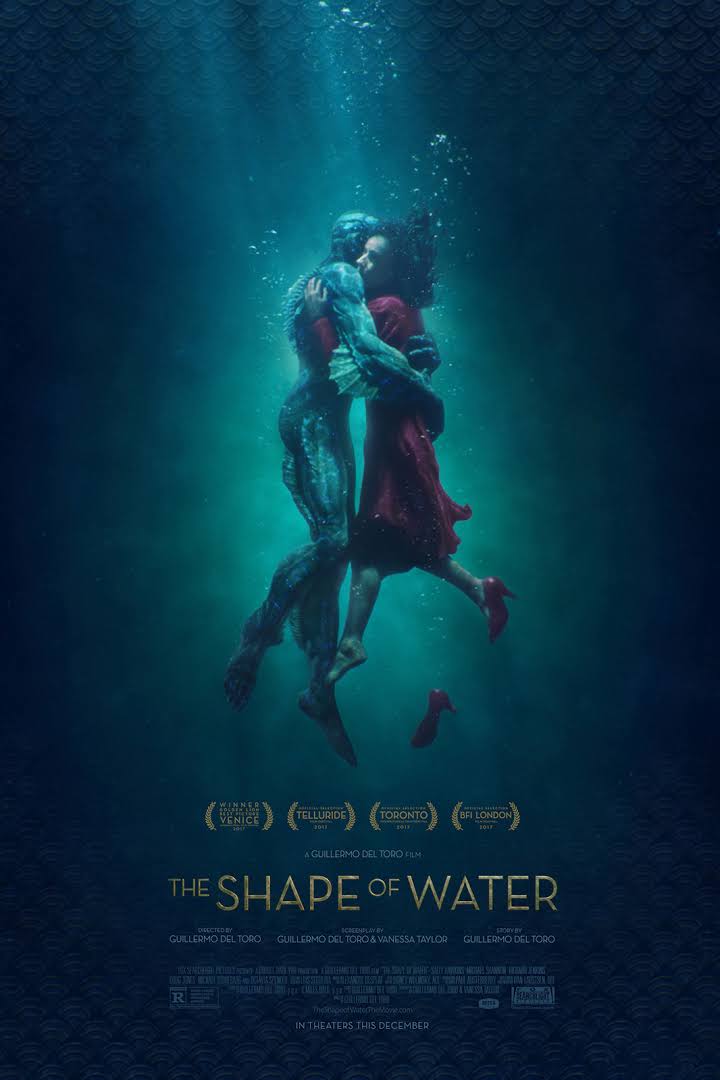
Guillermo del Toro’s earlier works straddle the line between historical material and the phantastic. The Devil’s Backbone and, especially, Pan’s Labyrinth offer stories that invite multiple contradictory interpretations (and, in fact, I think the conflict between the two main interpretations of Pan’s Labyrinth, and the ways in which they exist together and yet cannot be dialectically or otherwise collapsed into each other, speaks to much of how I feel about the life we are living together now). I believe they are essentially very well-told fairy tales. However, gothic elements are more strongly present in The Devil’s Backbone and del Toro’s more recent film, Crimson Peak, goes full gothic. I felt it substituted a heavily stylized presentation for what felt like a bit of a reduction in terms of substantial content. The Shape of Water also has some gothic elements (and continues to play games with colour, this time substituting aquamarine blue-green for the red used in Crimson Peak and so, when a character says that red is out and green is in, this is totally a line for del Toro’s fanbase). However, the story and characters felt more solid and I found them captivating. I very much liked all the characters. I loved this movie and the ways in which del Toro continues to hold together horror and beauty, zeal and love, gentleness and violence (although I thought the scene where the villain presses his hand over the mouth of his wife, thereby, I presume, providing backstory for why the charcter may be interested in the protagonist, was unnecessary). The Shape of Water harkens back to Pan’s Labyrinth, although del Toro has now gone “full fairy tale” instead of walking an ambiguous line.
However, as I was thinking about this more, I began to wonder a bit about the genre of “kindhearted women who fall in love with men who are monstrous.” Of course, del Toro consistently reverses our understanding of what constitutes a monster – generally, for him, the hideous and ugly are good and the conventionally attractive, wise, devout, or otherwise successful tend to be the true monsters – and this is all well and good but I wonder about the gendered nature of this. In particular, I wonder about the contribution of ugliness to notions of the monstrous. I am hard-pressed to think of a presentation where these roles are reversed – a monstrously ugly woman rescues an oppressed but beautiful man. In fact, the only film that I can think of that comes close is Let The Right One In (one of my all-time favourite films), but there the man being rescued is a boy and the girl doing the rescuing, well, it’s complicated. In fact, when it comes to portrayals of monstrous women (at least in the fairy tale genre, and I do want to keep del Toro situated there), it is often very beautiful – but coldly beautiful, beautiful in a way that is highly accessorized with furs or diamonds or makeup or whatever – women who are presented as monstrous and the non-monstrous women are women who end up being discovered as beautiful (in a much warmer way). The closest thing I can think for a monstrously ugly (keeping with conventional understandings of beauty here) heroine is in Shrek but, even there, Princess Fiona only remains an ogre because she is marrying an ogre. She chooses the form that best suits her man… so, I think, that kind of problematizes readings of Shrek that see it as super radical or feminist or whatever. It may challenge very basic notions about the value of conventional notions of female beauty, but it does so in the context of a woman choosing to sacrifice herself in order to be a good match for a man. That’s about as radical as Disney gets… Anyway, despite how much I like del Toro’s reversal of the monstrous (so much of it holds true for my own experiences in life), I am bothered by the gendered nature of this and its inconsistency and potentially troubling way of dealing with notions of beauty. If anyone can suggest a film where a monstrously ugly woman saves a beautiful man (who then falls in love with her and runs away with her/marries her/whatever regardless of what the world thinks), I’d like to know about it.
5. The White Ribbon (2009) directed by Michael Haneke.
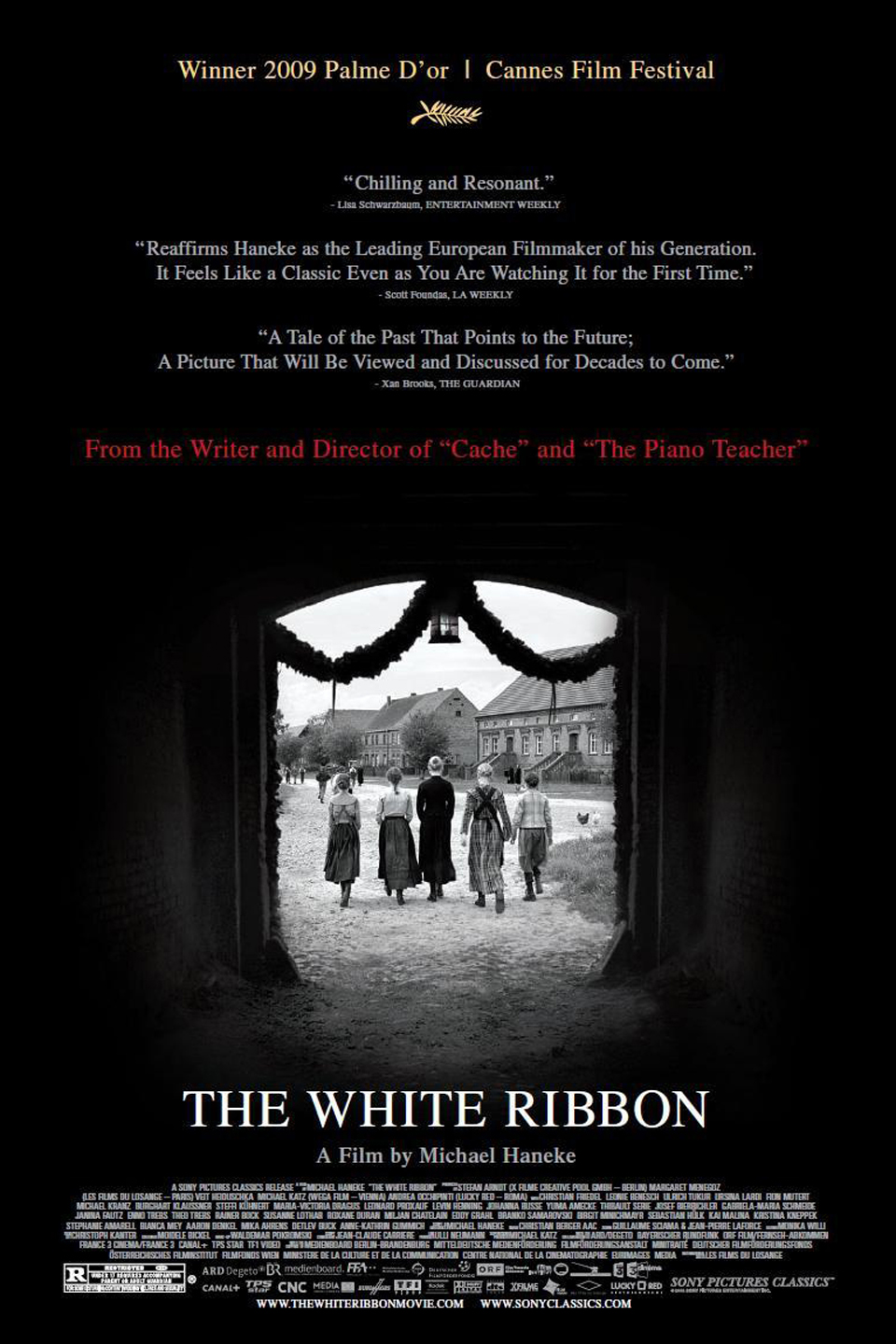
I’ve avoided Haneke for a while because he was feeling too dark and exploitative for me (Caché and Time of the Wolf were tense but bearable, but then The Piano Teacher put me over the edge… hated that film). More generally, beyond Haneke, I was feeling a bit put-off by some of the big name European Director bros who get a lot of love and attention at Cannes (Kechiche, von Trier, Noé, Warmerdam, and, although she’s not a bro I include her because of her connection to Noé and the controversy her films created, Hadžihalilović). However, two things happened. First, I forgot Haneke actually directed The Piano Teacher (for some reason, I thought it was Warmerdam) and, second, I kept coming across positive references to The White Ribbon. So I decided to watch it. And I really enjoyed it. There really is no questioning Haneke’s artistic ability as a Director but I tend to get tired of talent for the sake of talent (or genius for the sake of genius) unless I also connect with the content in some way (which is why, for example, I think I tired of DFW and Murakami… and feel a bit concerned about those who remain their fanboys… but that’s kind of tangential to all this). And I thought the content of The White Ribbon was solid. In particular, reflecting back on the film, I was struck by how I experienced some of the behaviour of the children in the village as more insidious or suspicious than the behaviour of the adults – even though several of the adults are much more explicitly violent and mean. The children are basically growing up to be adults like their parents, yet the violence of adults seems more to-be-expected and, therefore even if these expectations are framed critically, normalized than the violence of children which we take to be especially problematical or perverse or evil. This made me reconsider how a certain subgenre of scary movie (involving scary kids… Children of the Corn, The Ring, etc, etc.) reinforces a narrative that decontextualizes the actions of children from the actions of adults around them and the behaviours that have been transmitted to them, and thereby teaches us to blame children while exonerating adults. Part of what makes The White Ribbon Great is how it plays against that kind of decontextualized narrative. And, while the movie ends with the outbreak of the first world war, and the knowledge that Nazism isn’t too far in the future for these people, and while the film is a painstakingly executed period piece, it seems to me that we have a great cause for concern in our time and our place given these lessons.
Documentaries
1. Angry Inuk (2016) directed by Alethea Arnaquq-Baril.

Five questions I imagined asking Alethea Arnaquq-Baril after viewing Angry Inuk.
(1) Angry Inuk was released in May 2016 and, as I have tried to track its journey, it seems to have done very well, receiving high praise from several critics and being featured in multiple international film festivals. I think it deserves all this praise and publicity – in my opinion, it is excellent both as a film and as a work of political activism engaging in the defense of everything expressed in Indigenous notions of the land. Hopefully, all this consciousness-raising has also borne other results and shifted the approaches taken by law-makers and governments. Over the last year and a half, or since the film was released, have you seen results that have made a difference on the ground for people in your community and across the north, or are people still just as constrained and decimated by laws designed to erase their way of living? If positive changes have not yet happened on the ground, do you have any reason to hope that those changes might be forthcoming?
(2) One of the possibilities raised by your documentary is that the Canadian government, as well as other powerful economic players (like oil and mining companies – which have a long history of working closely with the Canadian government to decimate and plunder lands stolen from sovereign Indigenous peoples both in Canadian-occupied lands and elsewhere), have a vested interest in destroying the Inuit economy and driving Inuit off the land and away from traditional practices. In this way, perhaps Inuit peoples will end up reluctantly consenting to things like mining and offshore oil drilling. Keeping this in mind, what role did the Canadian government play in the seal bans that have impacted your community and what stance is the Canadian government taking now? Does it seem to have its eye on clearing a path for oil and mining companies or has it been offering meaningful and fruitful support to the Inuit in their struggle?
(3) It seems to me that a form of settler colonial racism is operative in much of the resistance to seal hunting and the buying or selling of seal-based products. This racism requires Indigenous peoples to just disappear – or, if they don’t disappear, then this racism allows their existence to be ignored as animal rights activists consistently ignored you and others before you. To pick another recent example, I suspect it also motivated protests that happened last October, in relation to a fabulous Inuit restaurant in Toronto, Kūkŭm Kitchen, that has seal on its menu (I didn’t see protestors putting nearly as much work or vitriol into protesting other restaurants in Toronto, the vast majority of which serve meat from animals treated far, far worse than the seal used in Kūkŭm Kitchen). In fact, I wonder if racism is part of what prevents the animal rights activists from recognizing that, as you say, you’re essentially fighting for the same thing (as far as I can tell, you want animal life to flourish and ecosystems to continue to be untouched by mining and oil companies so that life will be able to continue to flourish for many generations – although the traditional Inuit lifestyle is actually consistent with this desire, while the traditional animal rights activist lifestyle is not and the animal rights activists fail to recognize what many others have recognized; i.e. that predators, meat eaters, regularly contribute to the greater flourishing of life in a land as long as they maintain their proper place as members belonging to that land, rather than viewing themselves as members in possession of the land). Do you believe this is a factor? How much do you feel that your struggle to be heard, valued, and respected as an individual and as a people, is complicated by racism?
(4) In your film, you emphasize how the Inuit traditionally deal with anger in ways that are very different than in European cultures or in cultures developed in settler colonial States created by Europeans (the old school “rap battle” footage was amazing!). Traditionally, the Inuit are much gentler and much less explosive when it comes to anger. This seems to relate to what I have learned about Inuit Qaujimajatuqngit (which I began to explore about a year ago when I came close to taking a job in Inuinnaqtun). I was struck by the beauty and holistic vision of what it means to share life together communicated through principles like Pijitsirarniq (serving), Aajiiqatigiingniq (consensus decision making), Pilimmaksarniq (skill and knowledge acquisition), Qanuqtuurungnarniq (being resourceful to solve problems), and Pilirqatigiingniq (developing collaborative relationships and working together for a common purpose). Much of this is absent in mainstream Canadian society, just as being gentle in how we communicate anger seems absent among Canadians. And yet, despite all that is good about the Inuit way of sharing life together, you worry that gentleness and non-explosive anger may be a hindrance. After all, anti-seal protesters have been so successful, in part, because they were able to mobilize large groups of veey angry, very explosive protestors. In this regard, it seems like the Inuit are caught between a rock and a hard place – if they continue to live by traditional values, they risk continuing to be treated as though they do not exist and driven to starvation and life away from the land. On the other hand, if they adopt the tactics of anti-seal protesters, they risk sacrificing core values in order to be able to maintain their livelihood. The choice, then, is to either assimilate to Canadian values or die to make way for Canadian corporations. This, I think, is always the choice settler colonial governments give to Indigenous peoples but, as Indigenous land defenders and resistance movements have shown (and, as many have pointed out, when it comes to Indigenous life in a colonial State, existence is resistance), this is a false dichotomy. There are still other ways of living and other ways of surviving. In fact, I think your film, itself, is an example of a third way. Could you speak more to this issue? How do you hold on to values that are important to you and traditionally important to your people while also continuing to fight, not only for those values, but for political and economic structures that will help ensure that children won’t go hungry or die by suicide?
(5) Finally, what can people in other communities, be they in other territories occupied by Canada or elsewhere, do to contribute to the economic well-being and the survival of traditional values and practices of the Inuit? Do laws around sealing make it impossible for individuals to purchase products directly from hunters or artisans online or is this an increasingly feasible option in today’s world? What else can others, like myself, do to be useful in a ways that actually help?
2. Chasing Coral (2017) directed by Jeff Orlowski.
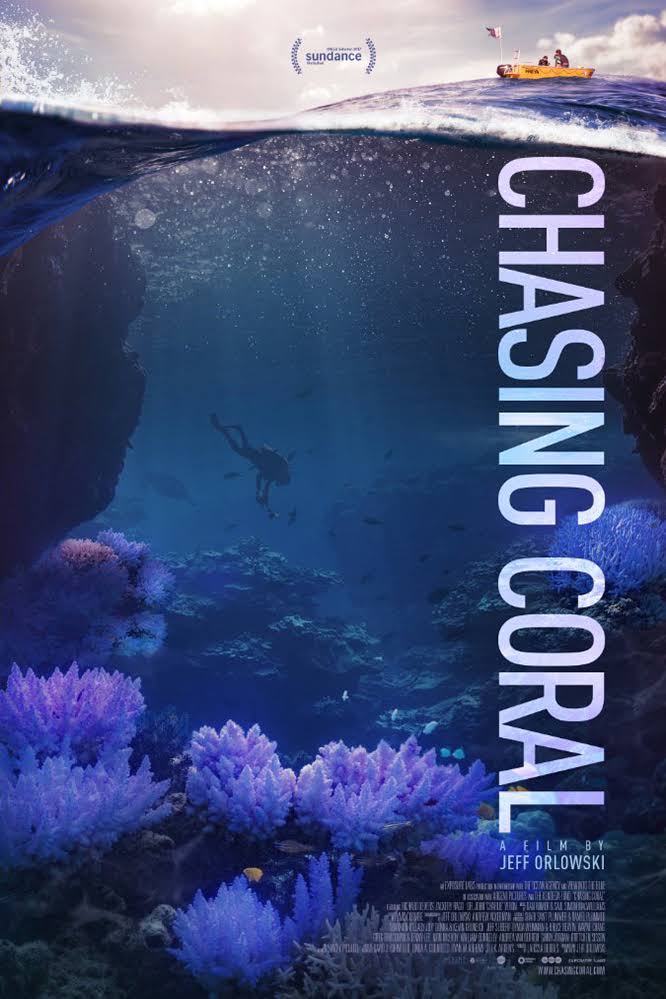
A series of before-and-after photos desperately in search of characters and a 90 minute storyline, I still cried when I saw the dead reefs. How can you not cry when you see that devastation and know that all of it is going, all of it is gone, it’s a foregone conclusion? People want to tout this film as a possible game changer in terms of climate change and allowing people to visualize and actually see the large scale results of the warming of the oceans (over 90% of the heat being produced by greenhouse gasses in the atmosphere is has been absorbed by the oceans), but I don’t know how that can be the case. It seems pretty apparent to me that, not only will this trajectory continue but those charting the course will continue on this road for as long as it is profitable, regardless of what it costs the world. There ain’t no turning this train around. My kids will look at videos of coral reefs the way I watched an old black and white film of a Tasmanian Tiger – the last one in existence – pacing the concrete floor of its cage in the Hobart Zoo. Huh, the will think, so this is something that was but is no longer. And maybe they will miss it as I missed the Tasmanian tiger, but I reckon they’ll get on with their day just as I did, too.
3. Burn Motherfucker, Burn (2017) directed by Sacha Jenkins.

The first of two documentaries I watched about the so-called LA Riots (the Watts Rebellion in ’65 and LA more broadly in ’92), I appreciated how Jenkins spent more time on Watts. However, I do kind of wish Watts was also examined in the context of the other uprisings that were taking place all across American-occupied territories in the mid to late 1960s (Rochester, Harlem and Philly in ’64, Cleveland in ’66, Newark, Minneapolis, and Detroit in ’67, Chicago, Washington, and Baltimore in ’68…). At times, I felt that the presentation of the subject matter bordered on being little more than a riot-porn music video (which, granted, isn’t necessarily a bad thing). However, Jenkins does do a good job of exploring how neighbourhoods of black poverty were created by city-planners and then occupied by racist white cops (often chosen and encouraged because of their racism). It is good for us to learn or remember the history of these things given the times in which we live.
4. LA 92 (2017) directed by Daniel Lindsay and T. J. Martin.
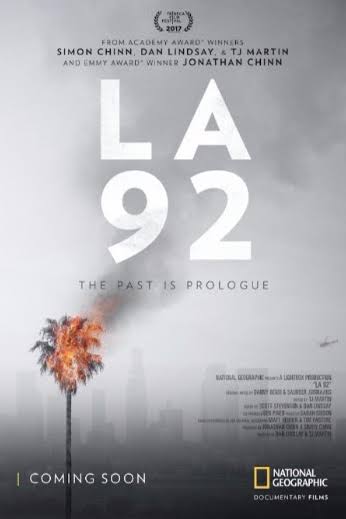
Lindsay and Martin are clear that the memory of these things is relevant to these times They frame their documentary about what happened in LA in ’92 with bookends that clearly bring us to more recent happenings in Ferguson and the Black Lives Matter movement. The spend less time on Watts than Jenkins but provide a more in-depth analysis of what happened in ’92. One of the most striking things about the film was an early quote from a white male newscaster commenting on the uprising. He described the “riot” as the most comprehensive and devastating act of racial violence in American history. That’s a pretty interesting comment to make in light of the American history of black slavery and the genocide of Indigenous peoples. That said, while I enjoyed both this film and, to a slightly lesser extent, Jenkins’ film, I think both of them are overshadowed by (of all things) ESPN’s totally phenomenal six part series about O.J. Simpson called O.J.: Made In America. However, one need not pick only one. They all compliment each other and, I think, one probably can’t spend enough time dwelling on these things these days.
I’m looking fwd to Alethea Arnaquq-Baril’s replies. I greatly admire her work. Obliged.